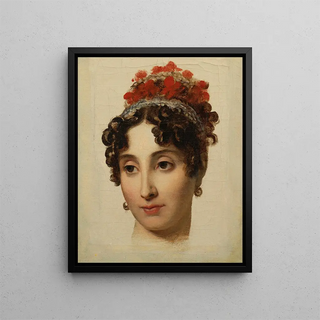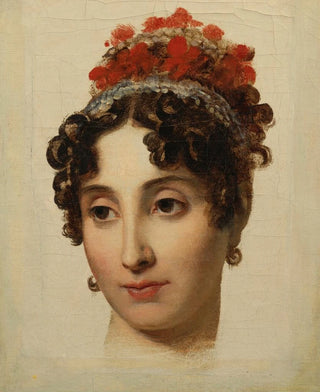Art print | Portrait of a young woman - François Gérard


View from behind

Frame (optional)
Portrait of a Young Woman - François Gérard – Captivating Introduction
The "Portrait of a Young Woman" by François Gérard is an iconic work that embodies the elegance and delicacy of the early 19th century. Through this painting, the viewer is immediately transported into a universe where female beauty is celebrated with rare grace. The young woman, with her gentle and mysterious gaze, seems to invite us to share an intimate moment, frozen in time. This portrait, which could be considered a simple exercise in style, actually reveals a psychological depth that transcends the genre of the classical portrait. Gérard, with his skill in capturing the soul of his models, offers us a window into an era where art and fashion intertwine in perfect harmony.
Style and uniqueness of the work
Gérard's technical mastery is evident through his subtle use of light and shadow that bring his subject to life. The delicate features of the young woman are accentuated by carefully orchestrated lighting, creating a play of reflections that enhances the texture of her skin. The chosen color palette, soft and nuanced, evokes an atmosphere of serenity and refinement. Details such as the draping of her dress and the intricately styled hair demonstrate meticulous attention to the elements that compose the whole. This portrait does not merely depict a female figure; it evokes a personality, a story, an essence. The pose of the young woman, both natural and posed, reinforces this impression of authenticity that is the true strength of the work.
The artist and his influence
François Gérard, a major figure of Neoclassicism, established himself as one of the most prominent portraitists of his time. Trained under Jacques-Louis David, he inherited rigorous academic discipline while developing a personal style that is uniquely his own. Gérard captured the customs and aspirations of his era, committed to immortalizing not only the outward appearance of his models but also their character and social status. His portraits, often commissioned by the aristocracy, reflect an era where art was inseparable from the representation of power. Gérard's influence is felt in

Matte finish

View from behind

Frame (optional)
Portrait of a Young Woman - François Gérard – Captivating Introduction
The "Portrait of a Young Woman" by François Gérard is an iconic work that embodies the elegance and delicacy of the early 19th century. Through this painting, the viewer is immediately transported into a universe where female beauty is celebrated with rare grace. The young woman, with her gentle and mysterious gaze, seems to invite us to share an intimate moment, frozen in time. This portrait, which could be considered a simple exercise in style, actually reveals a psychological depth that transcends the genre of the classical portrait. Gérard, with his skill in capturing the soul of his models, offers us a window into an era where art and fashion intertwine in perfect harmony.
Style and uniqueness of the work
Gérard's technical mastery is evident through his subtle use of light and shadow that bring his subject to life. The delicate features of the young woman are accentuated by carefully orchestrated lighting, creating a play of reflections that enhances the texture of her skin. The chosen color palette, soft and nuanced, evokes an atmosphere of serenity and refinement. Details such as the draping of her dress and the intricately styled hair demonstrate meticulous attention to the elements that compose the whole. This portrait does not merely depict a female figure; it evokes a personality, a story, an essence. The pose of the young woman, both natural and posed, reinforces this impression of authenticity that is the true strength of the work.
The artist and his influence
François Gérard, a major figure of Neoclassicism, established himself as one of the most prominent portraitists of his time. Trained under Jacques-Louis David, he inherited rigorous academic discipline while developing a personal style that is uniquely his own. Gérard captured the customs and aspirations of his era, committed to immortalizing not only the outward appearance of his models but also their character and social status. His portraits, often commissioned by the aristocracy, reflect an era where art was inseparable from the representation of power. Gérard's influence is felt in






